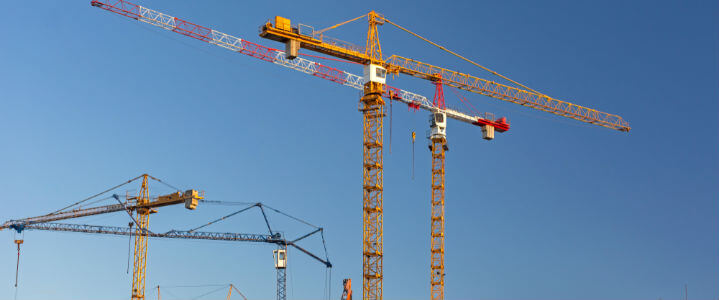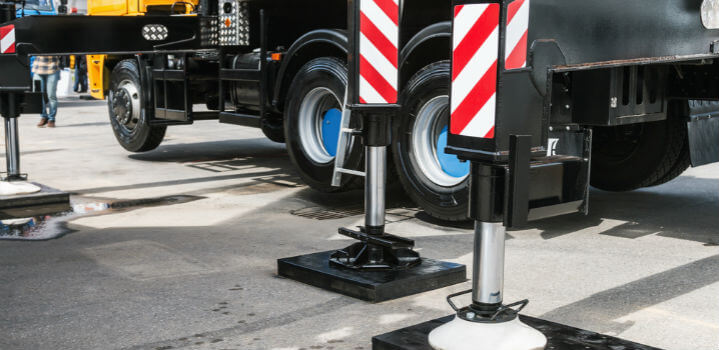Cranes are some of the most essential pieces of equipment in construction and industrial work areas. Your employees may be used to seeing many cranes daily. These machines are constantly running and are massive parts of production. Yet, perhaps workers see them so much that they take crane safety for granted.
Everything can change so quickly. These cranes pose potential hazards and extreme (even fatal) dangers. A tipping accident can take someone’s life in an instant. It’s a dramatic scenario, but it’s good to be mindful of what might happen if you aren’t taking steps to ensure crane safety standards.
Beyond workplace injury and death, crane accidents can cause more problems like damage to property or equipment loss due to a lack of crane operation safety standards.
Consider OSHA crane safety compliance and what it entails.
Importance of Crane Safety Rules on the Jobsite

Ready for some tips about crane lifting safety procedures and precautions? We hope the six below give you guidance. In addition, we encourage you to read about safety features in cranes and other pertinent information inside equipment manuals. Also, refer to OSHA’s extensive and exhaustive requirements regarding crane safety.
6 Essential Crane Safety Tips
Crane accidents are all too common, and most of them could be avoided. The following are the top five crane safety tips, ensuring that you and your team stay safe at the job site. While many of these tips take time and training, being safe as you do your job is worth it. It’s your responsibility to make your company’s workers aware. See that they practice what you preach.
1. You need a certified operator.
Cranes are potential weapons of mass destruction. In the wrong hands, disaster could unfold. Therefore, rigger safety training is a must. They should know how to calculate and set up specific loads in any situation. Train the trainer courses have proven helpful in this area.
2. Inspect and inspect again.
Sure, your crane needs its annual inspection, but don’t stop there. There’s more to the OSHA crane standard. A competent person should examine the operation function every day. Everything should run smoothly and properly, so report any suspicion of defects or malfunctions immediately.
Overhead crane safety tips are essential. These cranes have worked in extreme conditions for years. However, they can fail if they become too brittle or weak from the decades of heat in an industrial setting. Be sure your workers understand overhead crane safety rules thoroughly.
Use safety consulting firms like Safety by Design to train your workers. You’ll increase crane operation safety and production as well.
3. Look below.
The surface plays a significant role in crane safety preparation. Your equipment won’t function as it should if it rests on unlevel ground. Classify the soil. Take note of the material under your crane. You’ll have to adjust your loads and limits accordingly.
Tipping accidents occur because of this oversight. Load charts come in handy even when working on asphalt or concrete. However, you must take crane lifting safety a step further: what’s under the asphalt and concrete?

Crane outrigger safety is essential, too. Many cranes have outriggers, but extension does not equal a stable surface. Outriggers displace the weight, but the compression force could punch through the ground or surface.
4. Pay attention.
OSHA crane regulations are in place for serious reasons. The more you communicate these rules, the better everyone will memorize and practice them. Establishing clear lines of communication with construction hand signals, horns, or radios is a great idea. Use the OSHA crane safety handbook to identify proper signals. Teach your workers this all-important workplace language.
Better yet, use the Safety by Design OSHA training in Houston. With years of experience, our team can guide your team in crane safety equipment rules and general construction safety.
5. Plan for swing.
The swing radius is crucial. That area within the radius needs to be barricaded. The boom should be able to travel smoothly without hitting anything. Power lines can become a disastrous mess in this area of OSHA crane safety.
6. Always have a plan in place.
Every lift is different from the last. You need an emergency action plan, and you need to stick to it. Inspecting the equipment is vital. But assessing suspended loads, capacities, and weather (among other factors) represents the critical path. Get everyone involved—the operator, riggers, and surrounding workers. Utilize construction site medical services to prepare for emergencies.
Safety By Design Values Crane Operation Safety
Contact our team today for more information about how we can help you. The Safety By Design experts know OSHA inside and out. We explain and train—that’s our mission. We make your and your employees’ safety our priority, and we take pride in that priority and purpose. Learn more by reaching out today!



